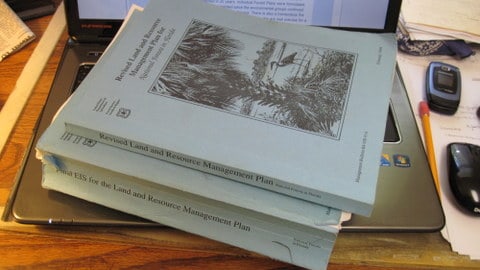 Photo courtesy of Mac McConnell.
Photo courtesy of Mac McConnell.
Note from Sharon: I am reposting this as I don’t think it got the attention it deserved yesterday because of a plethora of fire posts. It reminds me of something Chris Iverson once said about the Tongass and Chugach plans..along the lines of “if you’re not doing much (I think he meant in terms of vegetation changing work) you shouldn’t analyze much.” Is the Forest Service over”planning” and under”doing”?
Guest Post by Christopher Brong
Skamania County Commissioner, District 1
Here in Skamania County, WA, it is a big problem because there is very little active management for sustainable harvest and forest health on the Gifford Pinchot National Forest (80% of the County). The 1993 Pacific NW Forest Plan brokered by President Clinton, has not been implemented in 20 years. Individual Forest Plans were formulated, but, little of the plans have been implemented since the environmental groups continued their “file-a-lawsuit” process against the Forest Service. There is also a tremendous fire hazardous on this forest since little timber has been harvested. We are well overdue for a catastrophic fire predicted by several USFS researchers for the “wet” side of the Cascade Mountains. We receive nearly 100 inches of rain/year. Now, it seems the Forest Service would prefer to spend most of their yearly budget on fire suppression, instead of prevention. Since early European settlers arrived until the 1980’s, this region has produced billions of board feet of timber. This region is known as “*….the most productive natural temperate forests in the world.” The Forest provided significant timber harvest receipts to our County from the 1940’s up to the mid-1980’s.
The County encompasses Mt. St. Helens National Monument, 3 Wilderness Areas, 4 federal fish hatcheries, and 2 state fish hatcheries. 59% of the County is Critical Habitat for the Northern Spotted Owl, which continues to decline. 10% of the County is heavily regulated by the Columbia River Gorge National Scenic Act.
Another 8% of the County is in WA state timber trust and WA Parks lands. 10% is in very large private timber company lands. Fortunately the state trust lands provide a sustainable harvest of timber and the private timber provides a renewable harvest. These provide periodic timber harvest taxes that are minimally predictable.
Which leaves only 2% of the County that is taxed for private property taxes. Since we have depleted our Reserve funding, the County Government budget has been cut in half in the past three years, besides laying off 100 permanent and temporary employees. We are planning for “Secure Rural Schools” reauthorization to not occur, which will require laying off another 25 employees, and, 3 of 4 schools will be closed.
Recreation opportunities are abundant in the County and the region, and we do our best with the tax receipts to provide advertising and events from the customers primarily located in the Portland/Vancouver Region. However these receipts are primarily tourism directed funding, and the tourism job opportunities are below “living-wage” level. The service job wages for bussing tables, tending bars, and cleaning rooms are in the lower end… Federal Government jobs is the largest employer. Followed by the Service sector. Voters, and many urban folks, may believe public lands support the economy in a big way, but that is merely a perception based on lack of knowledge. Which brings me back to the Gifford Pinchot National Forest. The Forest Service is unable to implement their plans, due to funding and lack of manpower, continual NEPA and ESA lawsuits, and environmental opposition to virtually any type of timber management project. So other than law requiring plans, why bother if you can’t implement the plan?
Note from Sharon: Mr. Brong is our guest, so I ask all commenters to keep hospitality in mind as we agree or disagree. As Benedict of Nursia recommended (for whom the Benedict’s Corner sidebar is named), I ask that we also “listen with the ears of the heart.”

